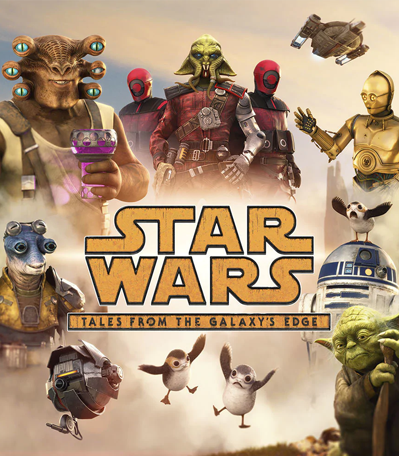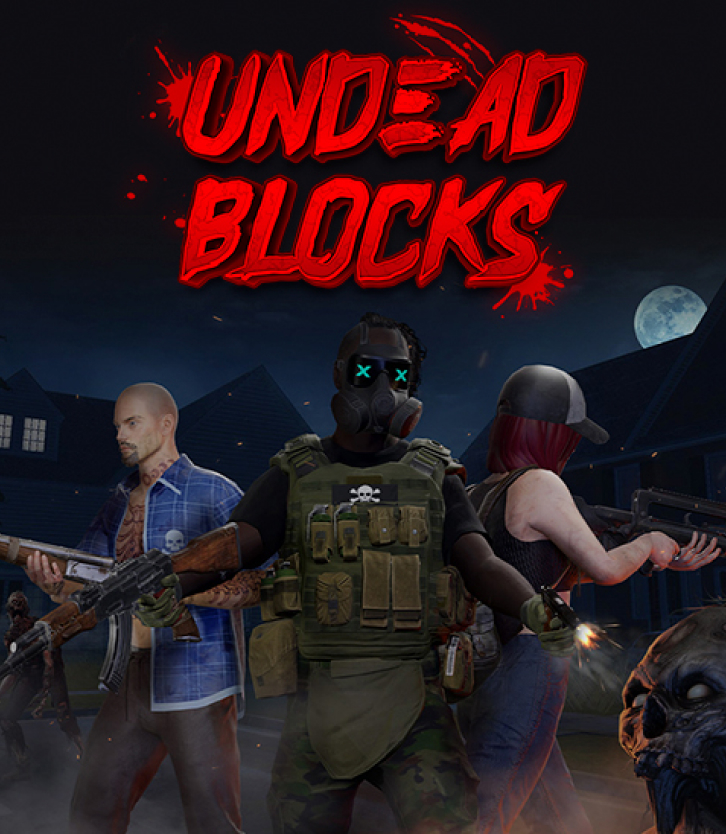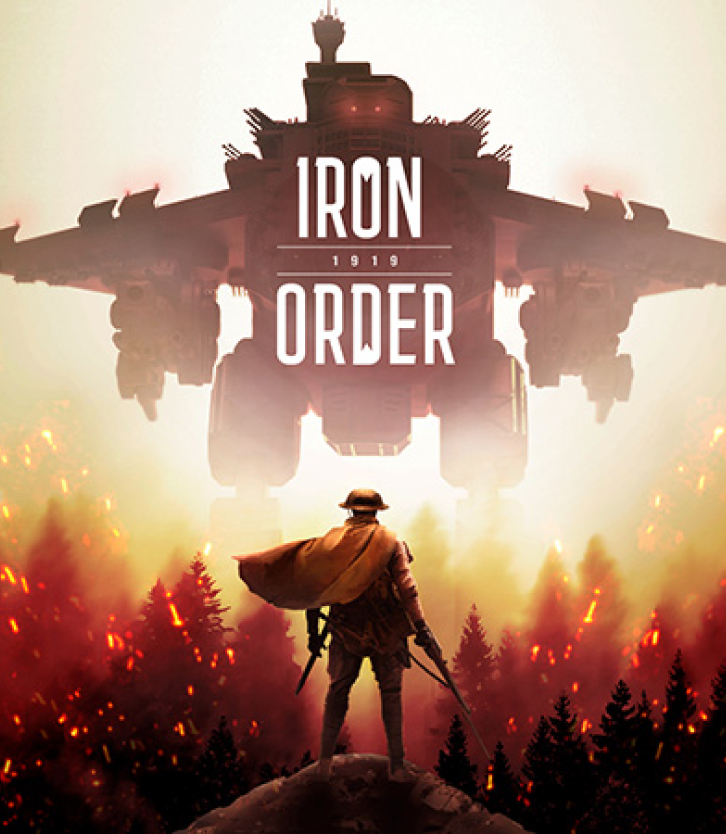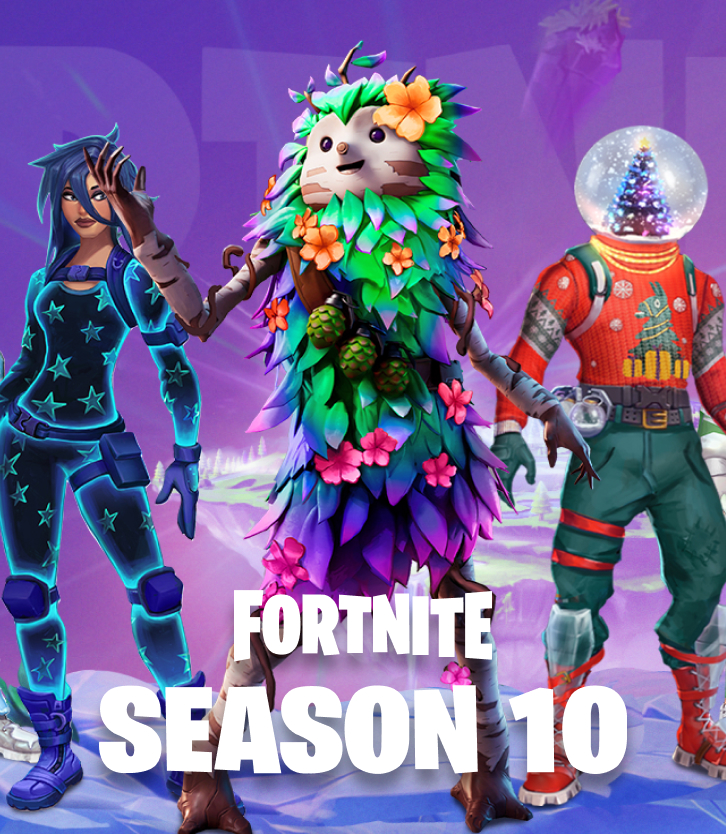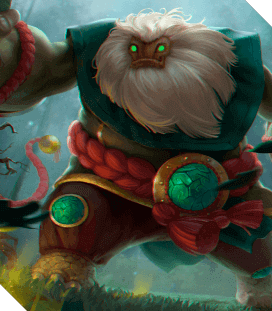If at some happy moment you come up with an original idea to create a game that has no analogues in terms of presentation, plot, or gameplay, but you have neither a team nor funding, then congratulations: the arrow of your internal game development compass has moved towards indie.
And that means you’ve come to the right place.
Indie Game: Definition
First of all, you need to understand that indie is not a genre, not a class, or even a type of games. It is rather a characteristic of the conditions for their creation. The gaming world is conditionally divided into:
- Sponsored products backed by publishers and investors and created for purely commercial purposes.
- Independent games without such financial support, but with the freedom and courage to put the idea ahead of profit.
So what is an indie game? These are projects that are created by independent developers.
Independence means that they do not work for large studios like EA or Ubisoft, but only for themselves. These are kind of individual entrepreneurs in the gaming industry. Typically, indie studios are made up of just a few people. Most often, their number does not exceed 10 experts. There are also indie developers who make games alone.
Find out how much solo developers of cult indie games Stardew Valley and Minecraft managed to earn
Dive deeperThe gaming industry is one of the richest markets in the world—it is now worth $269 billion—but that money rarely reaches independent teams. Due to the availability of training courses and the gradual simplification of the development process, there are more and more indie studios every year. But only a few achieve financial success. And often it is largely based on pure luck.
On the one hand, this means that most indie developers are wasting money and energy almost in vain. On the other hand, it shows that these studios have to look for innovative ideas and new ways to make games. After all, restrictions and high competition force you to be creative.
Indie Example: Superhot
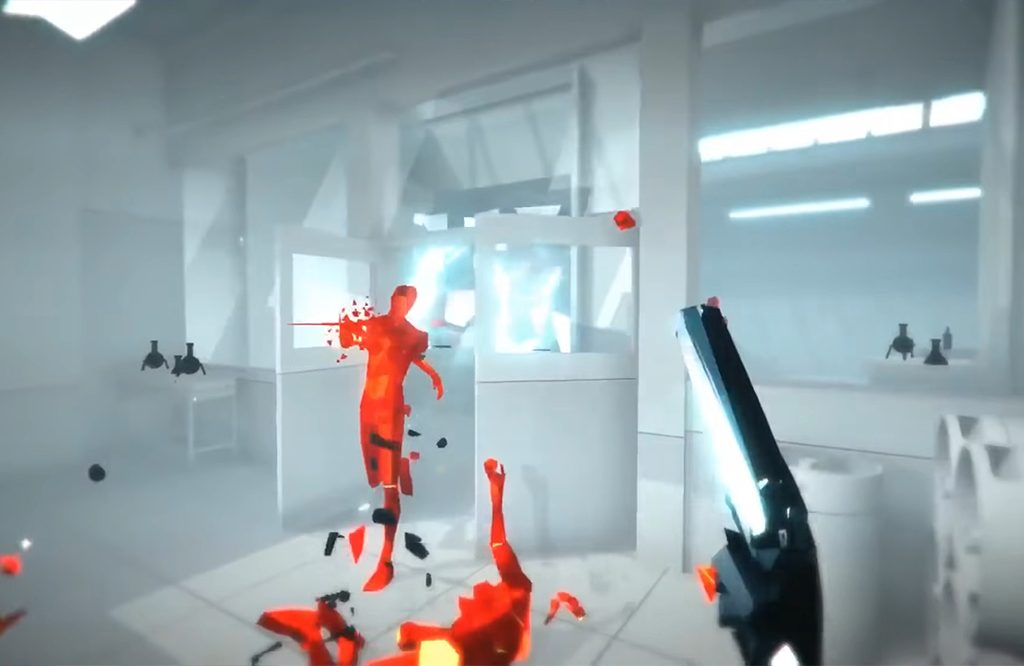
For example, let’s take a look at Superhot, a first-person shooter video game developed by the independent Polish Superhot team.
Game’s tagline: Time moves only when you move
The essence of the game is that time moves around players only when they move. That is, if the player suddenly stops, time also freezes.
The project was created in just a week as part of the 7 Day FPS Challenge in 2013. The widespread attention to the demo prompted the development team to create the full game. They received funding through Kickstarter.
In the first 7 hours, the creators of the game collected half of the required amount of $100,000, and by the end of the first day, the goal was almost completely achieved. As a result, the team raised $250,798, which allowed diversifying the game with additional challenges, a replay mod, and more advanced animation.
The PC version, released in 2016, surpassed the 500,000 mark in sales, generating $10 million a year after its release.
What Is Indie Game Development?
The word indie has nothing to do with India, as one might think. It is short for “independent”.
Indie game development is the process of creating a game by a small team or one person without the financial support of large publishers.
Indie developers do not have investors ready to fund all their ideas. Development money is most often raised on crowdfunding platforms such as Kickstarter, Indiegogo, and CrowdFunder. Some also use Patreon, a subscription-based website that offers regular support to developers. While the creation of the game is in progress, indie developers can share exclusive materials, artwork, backstage videos, and more with their patrons.
Indie Example: Night in the Woods
For people to believe in an idea and join it, it is necessary to talk about it thoroughly and passionately. That’s exactly what developer and composer Alec Holowka and animator and illustrator Scott Benson did when they created the indie studio Infinite Fall and announced the start of a fundraiser for the 2D narrative-focused adventure game Night in the Woods.
Game’s tagline: At the end of everything, hold on to anything
Seen for the first time, this phrase from the very beginning causes a vague longing in the soul and an inexplicable melancholy musing.
A detailed description of the game, its ideas, locations, characters, and music resonated in the hearts of more than 7,000 people, which allowed the team to collect the claimed $50,000 in 26 hours and quadruple this amount in a month.
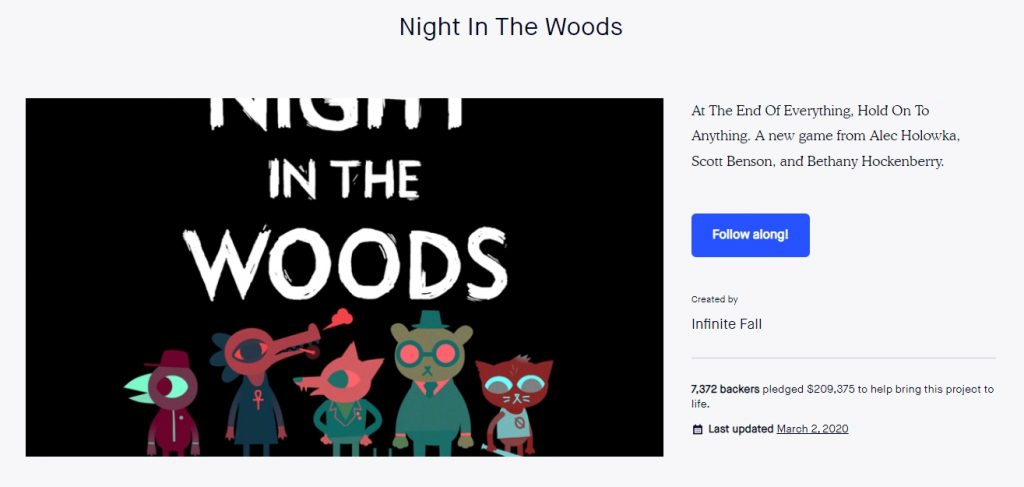
Player reviews about the game speak louder than any description.
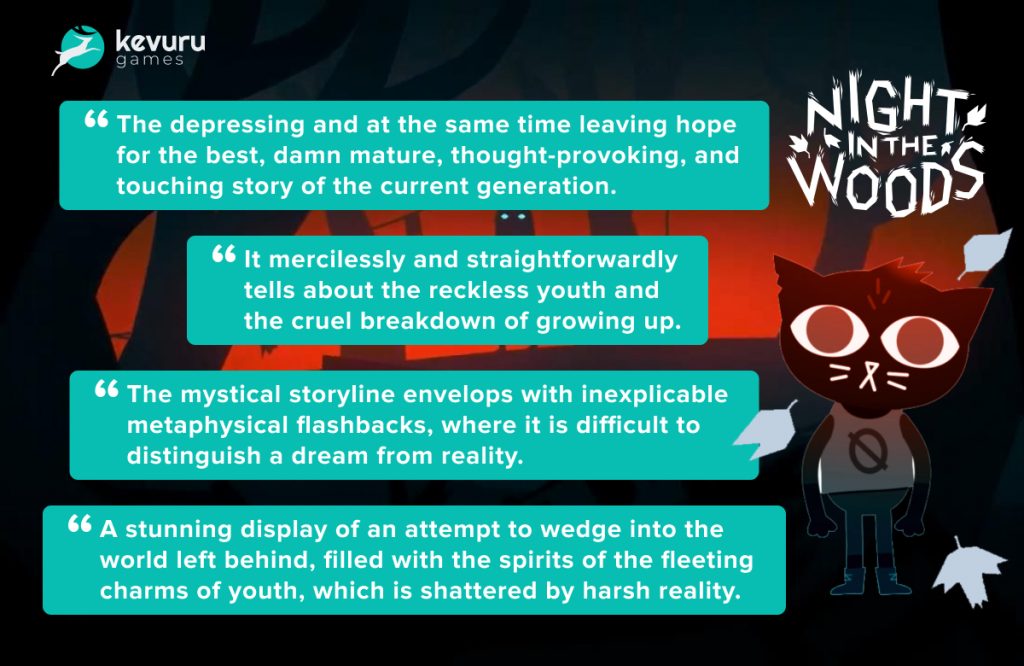
The authors seem to have turned their souls inside out and filled Night in the Woods with their feelings, experiences, pain, and desperate questions turned to nowhere. This is an interactive psychological novel that touches a nerve.
Through incredible and multi-layered dialogues, they raise many relevant topics:
- the transience of being and the injustice of the world;
- the reality of the soul and the piercing essence of growing up;
- the vagrancy of the body and mind;
- the search for faith and its justification.
Everyone will find in this game something that will touch the soul. And it worked. The breathtaking atmosphere of the game has attracted a huge number of fans to it, who, with delight and horror, find parallels between their fate and the fate of the characters, between the history of their city and the gradually fading breath of Possum Springs.
Night In The Woods won the award for “Best Adventure Game” in IGN’s Best of 2017 Awards, “Best Cast of Characters” in Giant Bomb’s 2017 Game of the Year Awards, and “Best 2D Visuals” in the Unity Awards 2017.
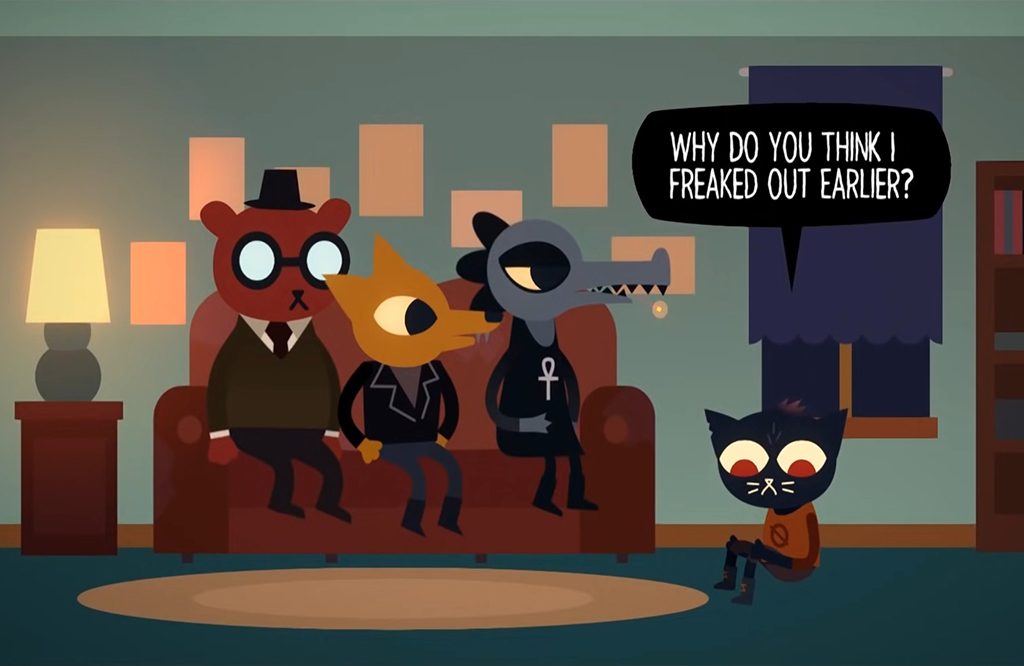
Who Is an Indie Developer?
An indie developer is someone who develops games independently or is part of a small development team that produces video games for PC and mobile devices without the financial support of large companies.
Unlike most big studios that create big-budget AAA titles, indie developers are not afraid to use fresh and risky ideas, rarely follow industry-recognized standards, and do not create products solely for the purpose of earning money. They can make an indie game based on their personal experiences, perception of the world, comprehension of current social issues, and more. It will not be a product with ultra-modern graphics and mechanics, but it will definitely be able to touch the heart and awaken the most intimate thoughts and feelings. What stands out indie game vs AAA?
True indie developers:
- do not conform to the standard needs of the gaming market and do not seek to tailor their skills to hiring a large game studio;
- are distinguished by the presence of versatile useful knowledge in the field of game development and promotion;
- often combine the experience of several experts: programmers, artists, designers, etc.
- have a great desire to constantly grow and expand their skill base in all areas related to the creation of games.
We define indie games as relatively low-budget games created by a small team independent of major publishers. There can be thousands and hundreds of thousands of such games. In fact, even one person can make an indie game. But how do indie developers get their game noticed?
| Don’t quit what you started | Indie developers are driven solely by their enthusiasm. They must be able to bravely confront criticism and negativity head on and keep improving their project no matter what. |
| Focus on quality | It makes no sense for an indie developer to create a large number of games and expect that one of them can be successful. This is an inefficient use of time and limited resources. The best strategy is to focus on one project and bring it to perfection. |
| Use original ideas | What makes an indie game a worthy competitor to the products of major studios? Their unusual plot and mechanics. Among indie games, you can find real masterpieces of storytelling, similar to interactive books, packed in graphics. Many of them become cult and gain a huge number of fans precisely because of their idea. |
| Promote your work | Indie developers are not backed by a strong marketing department: they need to talk about their product on their own. Announcements, trailers, press releases, promotional art, posts on forums and in thematic communities – everything will be fine. |
| Plan retention methods | Indie games usually fail to keep the player’s interest with new massive patches and DLC. In order for players to continue interacting with the game even after the end of the storyline, it is necessary to think over the mechanisms for motivating them to replay it to get new achievements, unlock interesting information, etc. |
| Decide on monetization | In-game purchases, ads, cross-promotions – standard game monetization methods are possible for indie games as well. They should be implemented very neatly and organically so as not to alienate the player. Some indie developers are moving away from standard monetization methods and simply selling the entire game for a fixed price. Users of the Epic Games Store, Steam, or other platforms pay for it once and get access to all its features. |
| Engage with the community | Once the game hits the market, you can’t leave it to its own devices. You need to track mentions, give comments, listen to reviews, answer questions, and in every possible way stimulate the interest of all those who are not indifferent. |
How to Fill the Missing Skill
There may be situations where you have an idea and certain skills, but they are not enough to cover the full range of work on creating an indie game. For example, you’re good at programming, but you don’t know how to draw at all. It is possible to find a temporary freelance companion, but no one guarantees the understanding and quality of what you expect. With a limited budget, any risk can be fatal.
A much more effective option is to order the desired art or animation from a game art outsourcing studio. Experienced specialists will quickly understand the essence of your request and immediately get down to business, ensuring consistently high-quality results. While they’re working on the art, you’ll be able to work on other aspects of the game and thus speed up the release significantly.

Team Composition To Create Indie Games
How to make indie games? Just like other games, given the fact that finances will be limited almost all the time.
And of course, no indie game can be made without a team. Even if it’s about one person.
Despite the fact that often each member of an indie team is a multi-instrumentalist who understands several areas at once, it is necessary to remember the composition of the core, without which it is impossible to create a single game:
- Game designer.
- Artist.
- Programmer.
- Sound engineer.
- Tester.
All these roles can be performed by one person. It is also possible that the programmer is good at testing, while the indie game designer does both art and animation. It’s just important to know what kind of work is ahead to make an indie game.
Let’s talk a little about each role.
Game Designer
More often than not, everyone on the small indie team contributes to the game design portfolio. This can be done by a programmer, sound designer, artist, etc. The main thing is that this person can see the overall and holistic concept of the game as the player sees it.
The contribution of each team member to the game design can be both positive and negative. On the one hand, there are a large number of interesting ideas and interpretations. On the other, there is a discrepancy between proposals and their possible inconsistency with the original idea. Therefore, it is important to have a game design document where the main points of the idea and style of the game will be spelt out. The whole team will rely on it as they work, and if there are questions or disagreements, they can reach a consensus.
Artist
An artist is a person who creates the visual component of an indie game. Art takes time and represents what players see during the game. Therefore, choosing a person for this role is a vital element of your project.
Working closely with programmers and designers, the artists will create the game’s visuals. It all starts with concept art before moving on to content that will appear in the game, including backgrounds, characters, animations, etc.
Artists also make sure that the content they create is technically compliant and builds the overall feel of the game. The more difficult the game, the more artists it is desirable to hire. This is especially true for 3D options with a large number of characters and locations. But if you are creating a retro platformer, then one artist can handle the creation of pixel art and animation.
Programmer
Your idea may be the best, but without hire game developers, it will most likely never come to fruition. A computer programmer is engaged in the development of the code base and tools for the game. Since video games are electronic entertainment, no programmer usually means no video game.
Note that the programmer usually does more than just coding the game while on an indie team. They will also take responsibility for debugging and beta testing to make sure the games are polished and acceptable.
Today, a game programmer does not need to know programming languages. There are many game engines (for example, Unreal Engine) that allow you to develop using blueprints, that is, visual programming.
A lot of indie games were made with just one programmer. So it mostly depends on the size and scope of your project.
Sound Engineer
The sound designer or composer will be responsible for creating all the sound effects and music for the game. Sound is a vital element in creating the atmosphere. Even if it’s not a horror game that needs scary music to enhance the experience, you still need a catchy tune to accompany your puzzle game or action platformer. Some particularly successful tunes become iconic for the game and even take on a new life in the form of fan covers.
There are many novice game sound engineers, and if you need one, then you should pay attention to specialists who have already done this kind of work before. For example, you can find someone who has already written chiptune music for other games if that style of music suits your project.
Tester
In most cases, this role is performed by the programmer. But it’s not always easy for them to spot errors in code they’ve been working on for many hours. Therefore, a fresh third-person view would be more relevant and effective here. The tester will carefully check the game and find all the inconsistencies, errors, problems, glitches, and crashes.
Your friends or volunteers who support your crowdfunding campaign, or anyone who enjoys playing games and can describe in detail what is going wrong can test the game and find glitches. But they can never replace a professional tester. It is better to allocate a budget for game testing services in advance if you do not want your game to fail purely due to numerous bugs.
Other Roles
We have listed the main people involved in indie development. There are other equally important roles that we have not highlighted in separate paragraphs, because in indie teams it is very rare to assign individual people to them. Most often, these roles are filled by those who are already doing some work on the project.
The first is a writer or a so-called narrative designer. Basically, any member of the team can write, tell the story, and shape the storyline. If the game is going to have a lot of text and dialogue, it’s best to at least have someone check all that text for errors before release. There is nothing worse than an indie game with typos in the text, creepy dialogues, and a boring plot, even if its gameplay is very beautiful and interesting.
The second is a project manager. The project manager’s job is to make sure the team is working quickly and efficiently, set deadlines, motivate team members that are lagging behind, and make sure everyone’s work gets done. Very often, indie developers fall behind easily and can miss deadlines because they don’t have a publisher or higher level person to push them. Therefore, they really need a person who will coordinate the work and maintain morale, whoever he or she is.
Pros and Cons of Indie Game Design
Indie games are very different from sponsored projects in many ways, both positive and negative. Our task is to give a complete picture of all of them without distortion and prejudice.
Advantages
![Pros of indie games - Indie Game Development: Guide to Revenues, Most Profitable Genres & Monetization [+ 10 Best Indie Games 2020]](https://kevurugames.com/wp-content/uploads/2021/04/baner01-3-1024x579.png)
| Unusual ideas | Indie studios are the main source of experimental projects in the gaming industry. Big publishers carefully weigh each step and figure out which concepts will make them the most money. Independent developers create the games they want and are not afraid to explore crazy ideas. For example, Getting Over It is an incredibly hard-to-control mock game designed to torment the less patient and show them that defeat is an integral part of the gameplay. Such projects are only possible in the independent segment of the gaming industry. |
| Fast feedback tracking | Indie studios are almost always small. Therefore, it is easier for them to respond to complaints and suggestions from players. It’s not uncommon for developers to fix bugs within hours of reporting a bug. In addition, independent teams add new content more easily and faster than major studios. The latter can only respond to error and bug notifications after they have come a long way, consisting of people from different departments. |
| Focus on a specific aspect | Unlike large-scale projects where developers can afford to cover everything at once, indie games usually stand out for one particular trait: beautiful graphics, unusual game mechanics, or an exciting storyline. The unusual presentation of these elements often results in players having a much more emotional attachment to the game than is the case with advanced AAA games. For example, the platformer GRIS has completely captivated players with its visual style, which is said to “leave a warm glow in the heart and be one of the most beautiful games ever made”. |
| No clear deadlines | What is an indie game but a creative expression of independence? The developer has no instructions from the publisher, no strict deadlines, and no threat of fines in case of violation of certain agreements. The indie team comes together to do what they want. The time spent on development is allocated by them voluntarily, they enjoy every minute of working on the project, and the game is a product of their pure enthusiasm and internal drive, which gives them energy to move forward. |
| Recognition and trendsetting | Indie teams will not get lost behind the big name of a famous publisher, their names will not sink into oblivion. They can speak freely about their role in their projects and proudly record this information in the credits. At the same time, new interesting ideas can be crucial not only for developers, but for the entire gaming industry, which will discover a new gaming trend based on a new breakthrough game. For example, the independent Danish studio Playdead had no idea that their puzzle platformer Limbo would become a cult indie game and even start a new art style for 2D games called monochrome. |
Disadvantages
![Cons of indie games - Indie Game Development: Guide to Revenues, Most Profitable Genres & Monetization [+ 10 Best Indie Games 2020]](https://kevurugames.com/wp-content/uploads/2021/04/baner02-2-1024x579.png)
| Lack of experience | Very often, indie developers lack the skills and experience to create a really high-quality game. In some projects, the gameplay is poorly thought out, which is why the player starts to get bored after a few minutes. In others, the interface is not intuitive or not very visual. Any aspect can be unfinished and spoil the overall impression of the game. |
| Limited resources | Independent developers pay a very high price for their independence: they need to take care of all financial issues and find the necessary resources on their own. This can be both personal savings and access to crowdfunding platforms. Budget restrictions can lead to poor quality graphics, short and too simple gameplay, skipping the testing phase, and problems with the promotion of the finished game. |
| Oversaturated market | After the overwhelming success of a number of indie titles such as The Binding of Isaac in 2011, the number of indie releases per year has begun to grow almost exponentially. Most of them were released on the Steam store, because new games were practically not moderated there. The website was filled with the first works of novice developers, low-quality projects, and clones of famous games. At the moment, about 20-40 games a day are released on Steam, almost all of them are indie. For players, this means that they will never know about most of these projects, even if they are really good. |
| Poor marketing | Lack of money, time, or effective PR skills means that the game simply goes unnoticed. Major publishers spend tens of millions of dollars on this, but some of their titles still fail. So, a project from a little-known independent developer has almost no chance to stand out without an advertising campaign. |
| Management problems | Often an indie team is a collection of good game art, design, and programming people who are not well versed in building coordination and management processes. They may find it difficult to balance the distribution of tasks, and some team members may be poorly organized and focused. Since the team does not have the extra resources to hire a project manager, they have to deal with all the problems of optimizing the workflow on their own. |
Top 10 Most Interesting Indie Games 2024
Despite the fact that many players accuse indie games of neglecting modern graphical achievements, their popularity among other players does not decrease. They are ready to support independent developers not only for the courage to challenge the grandiose AAA titles, but also for the twisted plots, touching stories, and hilarious twists that fully compensate for the minimalism of the art.
Let’s take a look at some of the most outstanding examples of indie games released in 2024.
1. Snufkin: Melody of Moominvalley
Genre: adventure
Platforms: macOS, Nintendo Switch, Windows, PS 5, Xbox Series X/S
Publisher: Raw Fury
Snufkin, a mysterious traveler from the Moomin series, as he returns to Moominvalley to find it disrupted by the construction of intrusive parks that disturb the natural harmony. The objective is to oppose Park Keeper, dismantle these parks and restore valley balance. Gameplay involves exploration, puzzle-solving, stealth elements, and the use of music as a core mechanic to interact with the environment and characters.
Developers based the events partly on Tove Jansson’s book Moominsummer Madness (1954). The game had good reviews and is enjoyed by both adults and kids. Take a look at the video to get a taste of its art and music style.
2. Thank Goodness You’re Here!
Genre: comic adventure
Platforms: macOS, Windows, Nintendo Switch, PS4, PS5
Publisher: Panic Inc.
The main character of the game is a short, balding traveling salesman who arrives early for a meeting with the mayor in the fictional Northern English town of Barnsworth (based on Barnsley, a real town in Yorkshire where developers of the game come from). Players walk around the town and assist its residents with various odd jobs, such as helping a man retrieve his arm from a sewer grate or delivering meat from a butcher to a pie shop.
The game is praised for absurdist humor and original hand-drawn animations. The dialogue is fully voiced, incorporating authentic regional dialects that add depth to the setting. Thank Goodness You’re Here! was nominated for Best Indie Game and Best Supporting Performer (Matt Berry) at the 2024 Golden Joystick Awards.
3. Balatro
Genre: roguelike deck-building
Platforms: Android, iOS, macOS, Nintendo Switch, PS 4, PS 5, Windows, Xbox.
Publisher: Playstack
Balatro is a card run-based game. As its developer, LocalThunk, said, “Balatro is a modern indie take on solitaire with a poker coat of paint”. The players can use jokers to modify the gameplay and invent strategies to rise up levels.
When you see a card game like this without having tried playing it, it does look surprising why it is so widely praised, has won several awards (including Best Indie Game by Joystick Awards), and has been nominated for Game of the Year. Sales figures are impressive, too: the game had made over US$1 million in gross revenue within eight hours of release. The secret to such a success is approachable design and innovative gameplay.
4. Little Kitty, Big City
Genre: adventure
Platforms: Nintendo Switch, Windows, Xbox.
Publisher: Double Dagger Studio
In 2024, black cats were in trend, as they were the main characters of the top animated movie of the year, Flow, and one of the most interesting indie games of the year, Little Kitty, Big City. In the game, players must help a kitten lost in a big Japanese city find its way home (and doing various cat things in the meanwhile). The city is an open world full of objects to explore and characters to become friends with and engage in the side activities.
The game is loved by the audience for its light art style, engaging exploration mechanics, and relaxing experience. Developer of the game Matt Wood said he was inspired by his cats Mario and Roxy and his children. The result is enjoyable for both adults and children. PC version of the game has scored 80 at Metacritic, and NS version reached 83.
5. Tiny Glade
Genre: city builder, sandbox
Platforms: Windows, Linux.
Publisher: Pounce Light
If one had to describe this game with one word, the first one that comes to mind is “cozy.” The pastel palette, soundtrack, nature… Everything in it is made to give that serene feeling when you can meditatively build something without risk of losing. There’s no risk to even build something unappealing, as the building materials are limited to medieval materials and idyllic landscapes. Tiny Glade was nominated for The Steam Awards in Sit Back and Relax category, and it’s surprising it didn’t win.
A game with very similar gameplay, Summerhouse, was released several months earlier than Tiny Glade, but the latter received a lot more downloads and overwhelmingly positive reviews. The key difference is aesthetics: Summerhouse is more squared and glitchy. Whether you want to dream of your own house by the seaside or a medieval castle, you have choice between the two great indie games.
6. 1000xResist
Genre: adventure
Platforms: Windows, Nintendo Switch
Publisher: Fellow Traveller Games
This is one of those indie games that is about tough and relevant issues like intergenerational trauma, the experience of members of diaspora communities, and the coronavirus pandemic. Developed by a team of four people with backgrounds in theatre, new media, dance and performance art, the game beautifully integrates different art elements in the graphics, motion, narrative, and gameplay. The game is set in a post-apocalyptic 2047. The main character is Watcher, a clone under the control of the enigmatic Allmother, who uncovers buried truths about the world through memory exploration and emotional storytelling.
At the end of 2024, 1000xResist was on many end-of-year lists but wasn’t nominated for awards. It surged some discussions online and placed the game in the spotlight. As the result, it reached top sales results on 2 January 2025, seven months after launch. Curiously, not being listed on The Game Awards helped promote sales, as more people discovered it and wanted to try and decide whether it deserved a prize or no. Also, it won the Best Narrative award at The Indie Game Awards.
7. Lorelei and the Laser Eyes
Genre: puzzle
Platforms: Windows, Nintendo Switch, PS
Publisher: Annapurna Interactive
This is a very aesthetic and stylish game with over 150 puzzles that can be approached non-linearly. Players control a woman involved in a mysterious project within an old mansion, exploring the environment from a third-person perspective. To progress, players must observe patterns, numbers, and connections.
The game’s monochrome visuals, along with its surreal storyline, make it truly stand out. The game was nominated for several Best Indie Game awards, and the players love it. It has 94% recommendations on OpenCritic.
8. Thronefall
Genre: strategy, tower defense
Platforms: Windows, Nintendo Switch
Publisher: Grizzly Games
Thronefall is positioned as a “strategy game for people who don’t have time”. And that’s exactly what it is: classic defense tower builder simplified to the level that everybody can enjoy it without dedicating too much time and without spending hours on understanding the mechanics. The visuals are simple and aesthetic at the same time.
Early access to the game was released in 2023, and it sold almost 1 million copies in one year before its full release in October 2024. Players take on the role of a monarch who prepares their kingdom to defend during the day and fight enemy occupants during the night. One has to balance investing in the economy or defense.
9. Slay the Princess – The Pristine Cut
Genre: horror adventure
Platforms: Linux, macOS, Nintendo Switch, PS 4, PS 5, Windows, Xbox.
Publisher: Black Tabby Games
The game is created from hand-drawn gray pencil scenes and plays with overturning a classic story: instead of saving beautiful princess the player must kill her, which is necessary to prevent the end of the world. The game presents players with complex choices, leading to multiple branching paths and endings, each influenced by the player’s decisions and interactions with the princess.
This game is proof that not only AAA blockbusters love sequels and expansions. Slay the Princess was initially launched in 2023, and after receiving a lot of praise from the public, in 2024, the studio released an expanded version, The Pristine Cut. The latter presented new features, 35% more content, and even a new ending.
10. Nine Sols
Genre: action, platformer
Platforms: macOS, Nintendo Switch, PS 4, PS 5, Windows, Xbox.
Publisher: Red Candle Games
The game is set in a colourful universe which developers call “taopunk”—a fusion of Taoist themes and cyberpunk aesthetics. The game’s character Yi is on quest for vengeance against the Nine Sols, tyrannical rulers of this deserted land New Kunlun.
The combat system is inspired by Sekiro: Shadows Die Twice, emphasizing precise deflection and strategy. All together—great combat mechanics, intricate story, quality level design, and beautiful graphics—earned it a place on various lists of the best indie games of 2024.
How Much Can You Earn on Indie Games?
Independent game development goes hand in hand with the belief that it is difficult to stand out here and the financial reward will not be too great. Every year there are more and more indie games, the field is very competitive, and many indie teams are not focused on creating a full-fledged interesting product.
Indie games are not limited to the creation process. It is vital for them to advance, attract the attention of potential players, and make themselves known on popular platforms.
The lack of a marketing budget or the unwillingness to spend extra money on advertising leads to the fact that players simply do not know about really good indie games. Therefore, once again we remind you of the importance of promoting your indie game: this can be a decisive factor in its success.
Now let’s talk about specific numbers.
According to research by analytics platform VG Insights that studied 21,000 indie games on Steam, half of all released self-published options do not generate more than $4,000 in revenue. They do not even cover the resources spent on their creation. About 25% of indie games have earned about $25,000 in their lifetime. Remember that these figures should be considered in terms of the time spent and the number of team members involved in indie game development. If the game has been developed for more than a year by several people, then this result cannot be called particularly successful.
All this would look very depressing if not for the rest of the indie games, proving that not everything is so hopeless. 14% of indie games have managed to break the $100,000 mark in revenue. The top 10% of the most successful and consistent have been able to earn over $150,000. This can already be called a success and evidence that a good product can make a profit even without huge investments. Most importantly, the 1% managed to raise over $7,000,000.
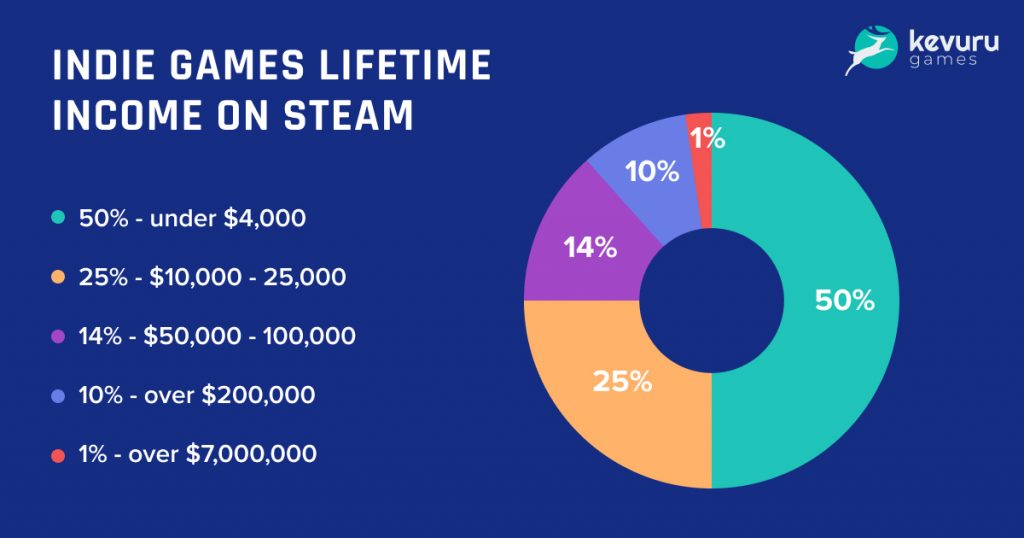
Of the 21,000 games reviewed, this is about 200 pieces that managed to do the impossible. For example, entertainment products such as underwater survival Subnautica and simulation RimWorld grossed over $100 million and sold millions of copies. During the coronavirus pandemic, Plague Inc. gained immense popularity, capturing over 130 million players worldwide and generating tens of millions of dollars in revenue. Subsequently, the developers of Plague Inc. donated $250,000 to fight coronavirus infection.
Most Profitable Genres For Indie Games
After examining the sales and revenues of indie games across a variety of genres, VG Insights uncovered an interesting pattern.
The most promising genres in terms of earnings are RPG, strategy, and simulation.
They are followed by adventure, action, sports, and racing games, which are worth choosing only if you are completely confident in your idea. The most inappropriate genre for indie games are casual options, in which the likelihood of high earnings is negligible.
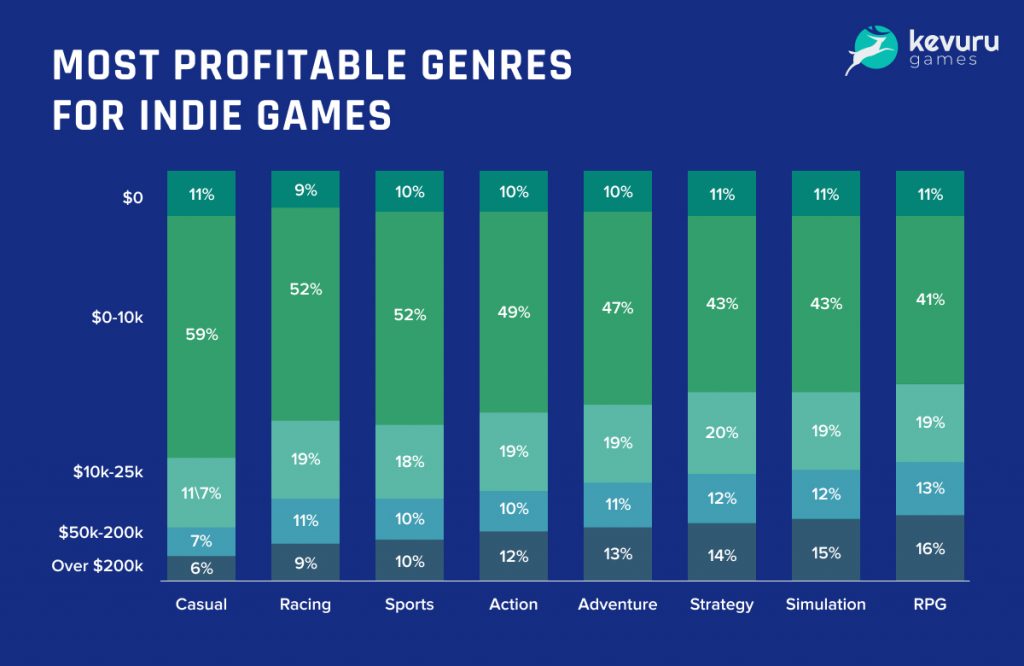
Models of Monetization in Indie Games
The indie game definition implies that people independent of the publisher are involved in the development. That is, virtually anyone with a sufficient degree of desire and enthusiasm can engage in indie development. And everyone is very interested in what methods of monetization can be implemented in indie games, in addition to direct sales in stores. We suggest considering the following options.
In-App Purchases
This is a classic way of monetization, which is suitable for almost all games. The bottom line is that during the gameplay, the player is offered some additional bonuses that will significantly improve and simplify the walkthrough or simply play a purely decorative role. These can be extra hit points, clothing for the character, bonus abilities, or weapons.
The most important thing is to give the player the freedom of choice and the ability to continue playing without making purchases. If you prevent players from moving on without committing a transaction, it could permanently push them away from the game.
Merch
The following options will only work if your game has already gained a certain popularity among some number of players. You’ve probably heard about merch – this is a very relevant option not only for the gaming world, but also for the film and music industry. For example, selling stuffed toys based on the Angry Birds game has become a huge source of income for the Finnish company Rovio, which started as a small independent developer.
You can sell anything: figurines of game characters, T-shirts and cups with their image, bags, shoes, key chains, wallets, and much more. The more players like your characters, the more likely they are to want to purchase physical replicas or items featuring them.
Partnership
Finding a partner can be quite problematic, but this does not make this method of monetization less effective. If you manage to find an interested person, then you can, for example, introduce a logo or mention of a partner into your game in accordance with the game setting, or offer other sponsorship services that will bring you additional income. This may be a notification to players that there are other similar games and a suggestion to pay attention to them.
Advertising
Video game advertising is a path that almost everyone who develops indie games eventually comes to: players don’t have to pay anything, they just watch ads. There are several main types:
- Banners. One of the most common types of advertising in games. A banner is a colorful ad image at the bottom or top of the screen. It’s very easy to implement, doesn’t interrupt the gameplay much, but catches the eye and can lead to a transition if the player is interested in the offer.
- Full-screen advertising. These ads, also known as interstitial ads, fill the entire screen, closing the game’s interface, remain on the screen for a short period of time, and then disappear. It can be either static or dynamic in video format.
- Push notification. These ads use pop-up notifications to grab the user’s attention and redirect them somewhere. It can offer both to buy additional elements for the game, and to switch to other websites and applications.
- Advertising upon exiting the game. These ads are triggered when a user leaves the game: this is a great time to advertise another game of your partner, for example.
How to create an indie game that generates income? You need to get used to the idea that this is not the area that consistently brings mountains of gold. This is a job for the soul, where earnings are rather a pleasant bonus that may or may not come, and you need to be prepared for this. At the same time, any monetization options you choose should be implemented very carefully and unobtrusively so as not to alienate the player from the main idea.
Indie games, corrupted by the desire to earn more at the expense of their essence, lose all meaning.
![Indie monetization - Indie Game Development: Guide to Revenues, Most Profitable Genres & Monetization [+ 10 Best Indie Games 2020]](https://kevurugames.com/wp-content/uploads/2021/04/baner01-1-1024x697.png)
How to Make an Indie Game Successful?
All indie developers want to know about this and at the same time understand that there is no exact answer. On the other hand, no one has canceled the functional analytics of the best-selling indie games. So, let’s see how similar projects on the Epic Games Store and Steam approach genre selection, gameplay, graphics, price, and marketing.
Graphics as an Auxiliary Element
The first difference between indie games and big AAA titles is their simpler graphics. This does not mean that it is bad. It can be very beautiful and eye-catching. This means that it is not the main focus of an indie game, but rather an auxiliary visual component to help you better immerse players in storytelling.
Therefore, for an indie game, it is enough to adhere to minimum graphical standards so that players understand what is happening on the screen.
You don’t have to try to impress players with modern graphical features, you can’t beat AAA games anyway. Indies do not undertake to compete with AAA in terms of the complexity of art, their essence is in a non-standard presentation and a fresh idea.
Indie Example: Hue
The graphics in the indie platformer Hue can hardly be called sophisticated. But at the same time, its presentation and the very essence of the game is a real artistic satisfaction. Fiddlesticks Games has offered an absolute innovation in game mechanics: the main character, a boy named Hue, explores colorless locations and finds new shades, which he uses to color the world around him. Puzzles and tasks that allow you to pass new and more difficult levels are based on the manipulation of colors, and there may be several options for solving puzzles. The alternation of static and dynamic levels will not let you get bored.
An amazing soundtrack, harmoniously changing depending on whether the atmosphere is tense or calm, makes solving puzzles a real aesthetic pleasure. Hue’s journey is based on the main heart-piercing plot that will touch anyone to the core: he is looking for his mother, who disappeared for mysterious reasons. On his way, he finds notes and memories that help him to better understand her past, the reasons for her disappearance, her study of the essence of color, and her inexplicable connection with the mysterious Dr. Gray, who periodically appears at the main milestones of Hue’s journey as if prompting him the right path.
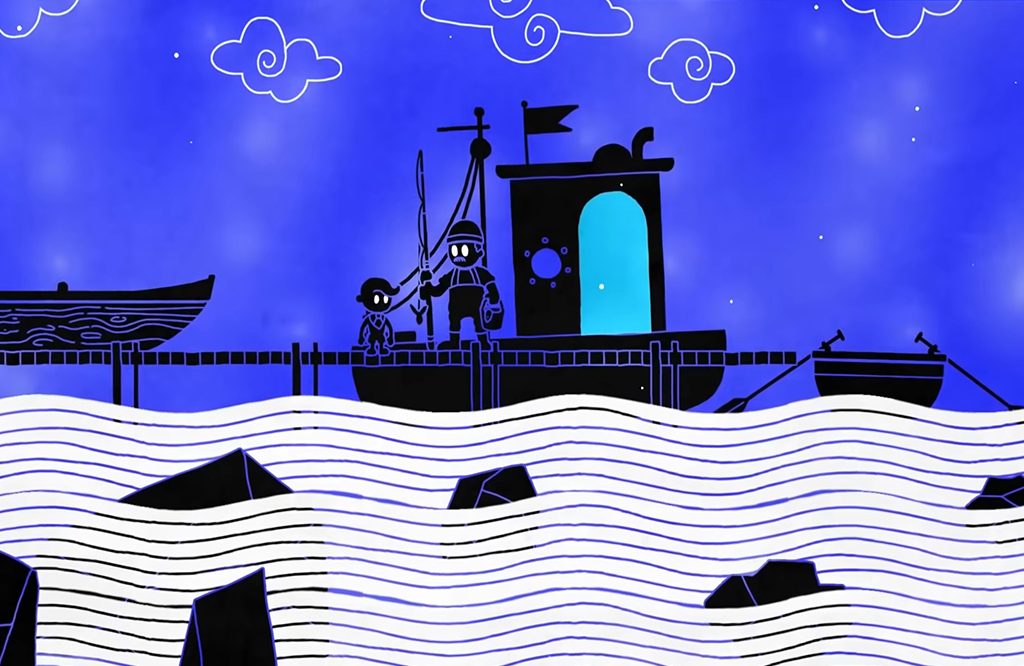
Unlimited Gameplay Options
Based on the previous point, you might think that a complex and intricate storyline is vital for an indie game.
There are options that do just fine without a storyline per se, for example, Game Dev Tycoon or any other simulator that relies not on history, but addictive gameplay.
It is important to understand that players have different moods and different needs at different times. Sometimes they want something simple, uncomplicated and funny, and sometimes they will prefer a leisurely philosophical story that invites you to consider many important life issues. Determine from the very beginning what audience you are targeting, and do not try to put everything into the game: it should be harmonious and unidirectional.
Indie Example: Game Dev Tycoon
Game Dev Tycoon is an addictive economic simulation game developed and published by Greenheart Games. The action of the game begins in the 1980s, when the gaming industry was just emerging.
The players begin by giving a name to themselves and their future company. Players can then create their own games by choosing a game theme, genre, platform, and game engine. Also within 30-42 years set-top boxes of well-known companies will be produced. Sony will be represented in the game as Vonny, Microsoft as Micronoft, Nintendo as Ninvento, Sega as Vena, etc.
Initially, players start developing games in their garage, but may soon purchase 2 new offices. In offices, players can hire other game developers and work collaboratively with them.
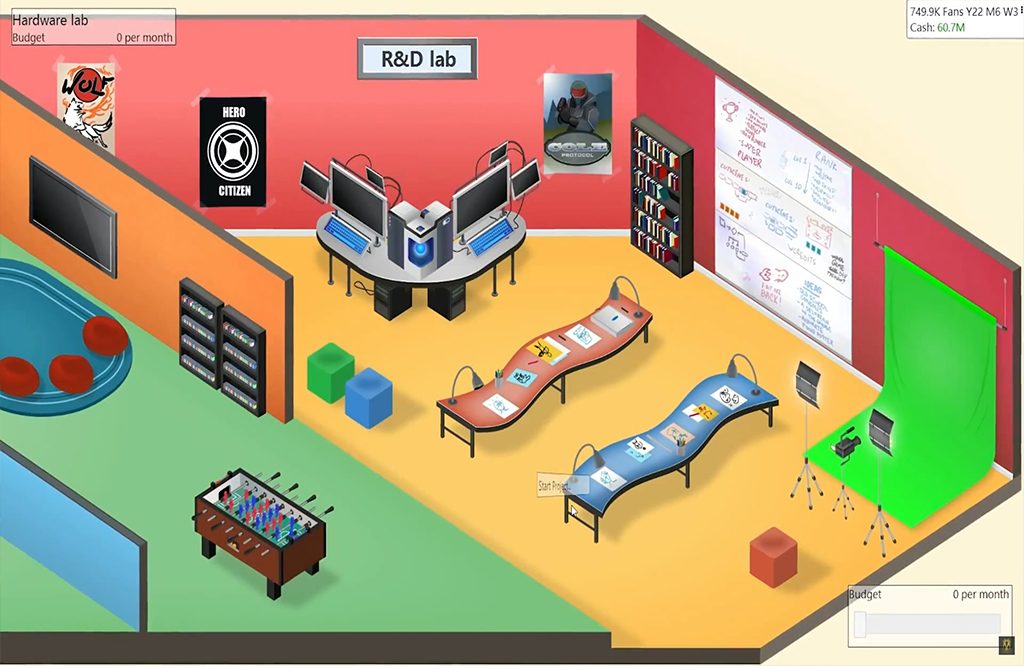
Unique Feature
If AAA games have an average positive rating of 79%, then for indie games it can sometimes go up to 87%. At the same time, it is noted that the players are much more warm and sympathetic to indie games, realizing that they are not made by rich corporations, but by the same ordinary people, united and inflamed by a common idea.
The intimacy of indie games and the imprint of the developer’s soul in them invites much more participation and sincere comments on them.
Indie Example: Castle Crashers
The best indie games always show some kind of innovation, be it a feature of the gameplay, graphics, storyline, or game design. For example, Castle Crashers arcade offers very simple hand-drawn graphics, but its gameplay is so addicting and unusual that players give it 96% positive feedback.
The game takes place in a fictional medieval universe. From one to four knights (depending on the number of players) take part in a party in the king’s castle. Meanwhile, a dark sorcerer steals the mystical royal jewel and captures the four princesses. The king sends knights to retrieve the stone, rescue the princesses, and bring justice to the sorcerer.
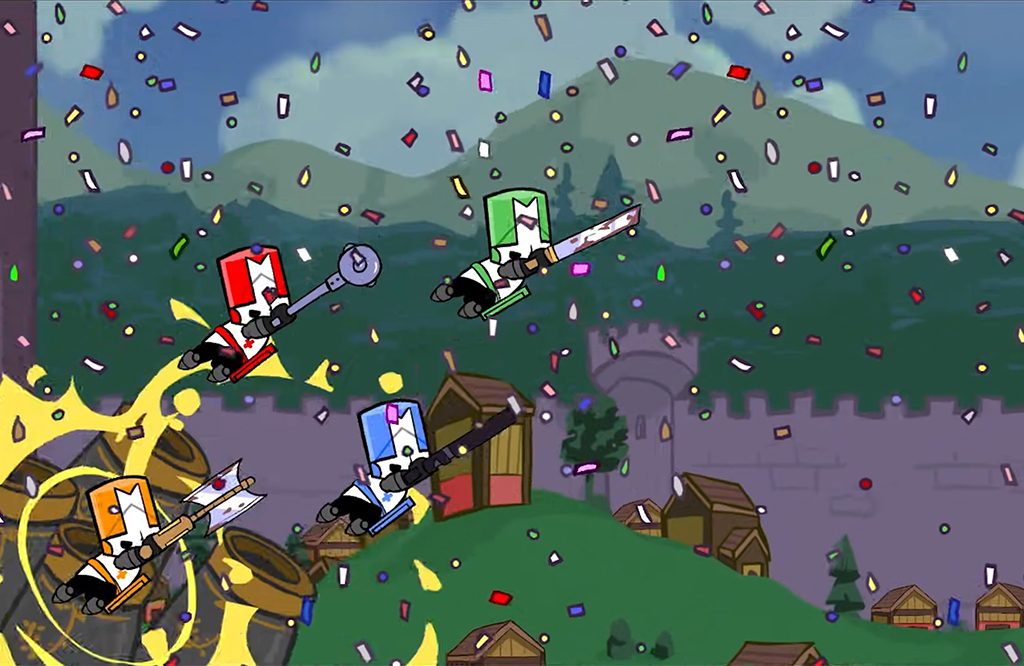
Successful Genres
We have already said that some genres of indie games are much preferable to others. RPG, strategy, and simulation will be the best choice. They do not require many years of complex development. If you are planning an adventure or quest game, then you will have to work hard to grab attention with a story and plot: the competition is high here.
Indie developers better stay away from racing and sports games, as this is already the territory of big-budget AAA franchises with cutting-edge graphics.
Remember that indie games compete with other games not for their graphics, but for their creativity, story, and innovative ideas.
Correct Price
Many indie developers tend to undervalue their games, believing that this will increase sales and attract more buyers. On average, they charge $7 per game. Many are limited to the $5 price tag. At the same time, the best indie games sell for $15, which is close to the cost of AA and AAA titles.
There is no need to artificially lower the cost. You have to evaluate the game by its quality, that is, consider the entire amount of work done and make a financial verdict.
Too low a price raises questions and doubts whether your product is another option of controversial quality, which is better not to pay attention to.
Technological and Localization Availability
The more people who can play your game, the better. The best indie games are available for both PC and Mac. Despite the fact that the Mac accounts for only 17% of the device market, it is still a large audience that is often deprived of games because developers do not care about adapting them to this device.
In terms of localization, the most popular languages are English, French, and German.
The best indie games expand the available languages to 7 with the addition of Polish, Chinese, Spanish, and Portuguese. This allows you to potentially increase your reach from 1 billion players to 3-4 billion. Many people will prefer to play the game in their native language if it is possible and are more likely to recommend it to friends.
Marketing Matters
The more people who know about the game, the more likely it is to succeed. Someone might purposefully search for a product similar to yours, but find nothing because you decided to bypass the ad campaign.
The best indie games never ignore marketing in one way or another.
This does not mean that you need to go to an advertising agency and pay them crazy money, twice the cost of development. These can be social media campaigns with captivating trailers and art, press releases, intriguing ads, and themed events. Games accompanied by such promotional efforts become known and expected even before they are released.
Reliable Companion in Indie Games Creation
Indie game development is an incredible barrier-free world where any of your craziest and brightest ideas can come true. You may encounter certain obstacles, but the most important thing is that you already know them by sight and are ready to achieve your goal, no matter what. Just don’t stop and keep moving forward. And Kevuru Games can become your trusted companion with game development portfolio if you need help with a certain aspect of creating your unique indie game or AAA games.

